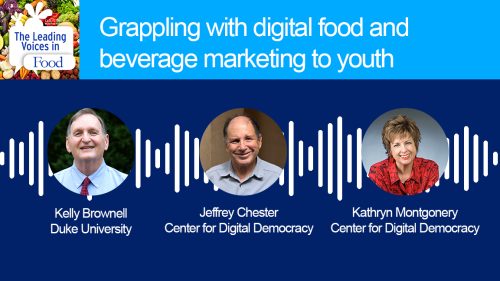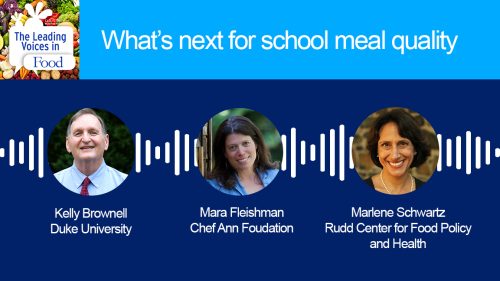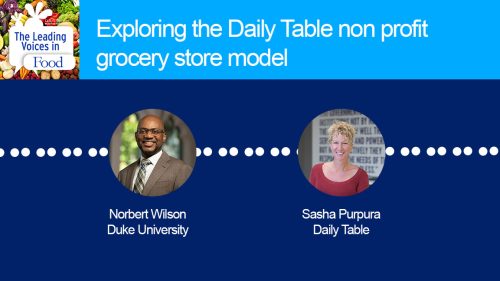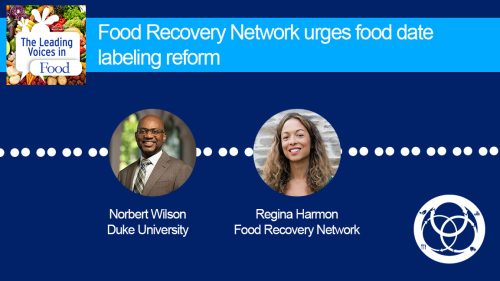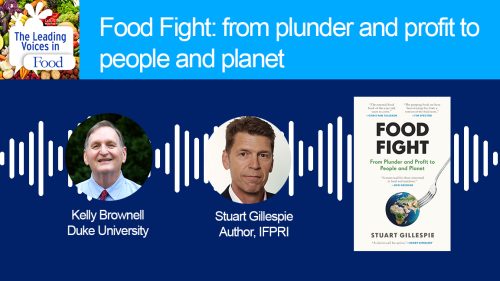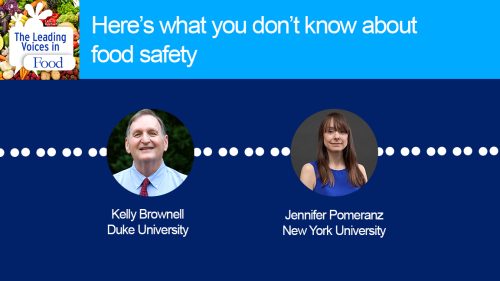The Leading Voices in Food
E262: Impact of skimming and shimming fraud on SNAP recipients
On our podcast, we have often talked about the Supplemental Nutrition Assistance Program, or SNAP. In many of those conversations, we’ve talked about the benefits and eligibility, and ways to improve the work that SNAP does to help low-income families meet their food needs. In today’s podcast, we’re going to turn our attention to a particular challenge, and it’s the SNAP skimming fraud. To help us understand this and the larger context of SNAP, we have the great pleasure of talking with Salaam Bhatti, who is the director of SNAP at the Food Research and Action Center, or FRAC.
Subscribe: Apple Podcasts | TuneIN | YouTube Music | SoundCloud | PocketCasts | Radio Public
Tags: Advocacy & Food | Food Insecurity | Food Policy |

Salaam Bhatti joined FRAC in November 2023 as the SNAP Director. In this role, he works to strengthen SNAP access and benefit adequacy. Salaam works closely with the Interim President to develop, lead, and track annual work plans; set and meet unit goals; collaborate with other unit Directors to assist in achieving FRAC’s strategic plan goals; and expand the unit’s innovation and work. Salaam joined FRAC after working at the Virginia Poverty Law Center (VPLC). While at VPLC, he successfully lobbied to fully repeal the drug felon ban for SNAP and TANF, twice achieved record increases to TANF cash benefits, subsidized reduced-priced school meals, repealed the TANF family cap, ended lunch shaming policies in schools, and received a unanimous vote to expand SNAP for over 20,000 families. Salaam also helped develop a mobile-friendly, SNAP screening tool which is used by tens of thousands of people & multiple non-profits and has been rolled out to be available for all states and D.C. He received the Young Alumni Achievement Award from Albright College for his work in alleviating poverty and promoting Muslim-Jewish relations. Salaam also received the inaugural Stuart A. Freudberg Award for Regional Partnership for his work with Maryland and DC Hunger Solutions to address food insecurity across the metropolitan Washington area from the Metropolitan Washington Council of Governments. Salaam has a J.D. from Touro Law School, is barred in New York and Virginia, and received his Bachelors in Political Science and International Relations from Albright College (with a year abroad in the University of Aberdeen).
Interview Summary
So, let’s provide a little bit of level setting for our listeners. Can you tell us what role SNAP plays in the lives of individuals who are facing low income or food insecurity?
Yeah, Norbert, the problem with being in the richest, most powerful nation in world history is that we are facing a food and hunger crisis. We have the means, we have the resources to solve for it, but we haven’t. For the record, the USDA, the United States Department of Agriculture, did a study last year. They do this study every year where they report food security in the country. In 2023, 86.5 percent of U. S. households were food secure. The remaining 13.5 percent, which is 18 million households, were food insecure. And this was an increase from 2022. So, 86.5 percent of food security is barely a B+. To be in the most powerful wealthiest nation in the world and we’re barely getting a B+ in this space is unacceptable. And so, we saw some really interesting policies happen during the pandemic. We saw emergency allotments come in for the SNAP program, where all households received the maximum benefit amount for their households. And that, unfortunately, sunset. When that emergency allotment was in place, food insecurity-surprise, surprise-decreased. But not just that, we also saw Medicaid healthcare spending costs decrease as well. Because who would have thought that when people had food security, they didn’t need to go to the emergency room because their blood sugar was low. So, we’re experiencing a lot of challenges where we’ve seen the government show its hand that it can end poverty. It can end hunger. It just chooses not to.
We know that SNAP is an entitlement program. It’s available to anyone who meets the eligibility requirements. But we know that everyone who’s eligible doesn’t participate in the SNAP program. Can you help us think about how more people can be enrolled who are eligible. And maybe we even need to think more broadly about what is eligibility? What are your thoughts about this?
In a given month these days, about 42 million people participate in SNAP. That’s a lot of people. I would say that 42 million people are participating in it every day, but unfortunately, SNAP benefits do not last the whole month. By the third week of the month, people’s SNAP benefits have been exhausted.
Now, taking a step back, in case the listeners don’t know how SNAP benefits work, it’s a, as you said, a government program. And it comes in the form of an electronic benefits transfer card, an EBT card. It looks like a credit card, looks like a debit card. But really, it’s more like a hotel card key, because it doesn’t have the security measures, which we can talk about later in the show. It doesn’t have the security measures that a credit and a debit card have. It is essentially a glorified hotel key. It’s got the magnetic stripe on the back, circa 20 years ago. Maybe 15. I’m dating myself. I don’t know how long ago it was we were swiping the cards. But all you gotta do is you swipe the card and you type in your PIN. And then you can use it at the EBT retailer. That is in a nutshell how 40 million people are utilizing SNAP benefits every single month.
The program itself is also vital to retailers as well. We’ve seen that every dollar of SNAP benefits generates about $1.54 in economic activity during an economic downturn. So that means that when somebody is using their SNAP benefits at the grocery store, it’s helping that grocery store keep the lights on. You know, employ the cashiers. And we need to employ cashiers, enough of this self-checkout stuff. It helps to pay the truck driver who’s transporting the produce to the store. And it ultimately even helps pay the farmer for growing the crop. So, it’s a great investment from the federal government into not just our households to help them put food on the table, but really into the whole local economy. And it is immediately used directly by the people and helps so many people.
Now so, to your question about how do we enroll more people? Well, luckily we are at a time where the USDA reports that in the fiscal year 2022, 88 percent of eligible individuals were participating in SNAP. And that is the highest participation rate we’ve seen since they started tracking this in the past 50 years. That’s great. But again, it’s just a B+ so we can do better. There is room to improve. In the study, it showed that older adults, those who are over 60, they’re participating at lower rates with only 55 percent of eligible members in that age category participating. We also have so many military families and veterans who are eligible, but don’t participate.
This SNAP gap is something that our partners are working throughout the states, throughout the entire country. We’re working in partnership with a lot of federal agencies and partners as well. So, how do you ultimately close the SNAP gap? We’re seeing a lot of targeted outreach. Seeing a lot of education efforts, but, you know, with 88 percent of eligible people participating, what’s going on-on the local level? And unfortunately, Norbert, we’ve seen that state agencies which administer the SNAP program are unfortunately understaffed and they’re underfunded. I used to be a state advocate at the Virginia Poverty Law Center. And when I was, hustling in the halls and lobbying for a million households with low income, I became friends with our social services agency because we had similar goals. We wanted to help households with low income. And we came to learn that the agency that we are relying on to administer the program was never getting their budget met by the legislative assembly. So, what we did was we got into partnership with them to advocate for their budget so that they could retain their staff, and so that the staff could do the job. That is something that we have to do across the states. Support these social service agencies in getting the funding so that they can have the staffing so that they can administer the programs in a timely way.
Unfortunately, I don’t know if you’ve seen this but earlier this year, the USDA Secretary Vilsack sent out a letter to like 44 state agencies, including D. C. and Guam. Being very concerned about their timeliness issues because they’re supposed to complete the application reviews and determine eligibility within 30 days. And that’s for a normal SNAP application. You have seven days for expedited applications. And 44 of these agencies were not meeting the mark. That’s bad for, in terms of deadlines, but even worse for the families experiencing the food insecurity. So that is a very layered answer. It’s the seven-layer dip answer of how we increase participation. Well, we need more staff to, to help that out.
I hear that, and I’m really grateful for how you hit it at this point, and I want to draw a little more attention to it. While you talk about 88 percent participation, it looks different on a state-by-state level. Some states have a higher level of participation, other states don’t. Do you think it’s really the ability of those state agencies to provide that support, or do you think there are other factors that may be influencing the differential participation rates across states?
Yeah, so we saw a big retirement, the great resignation, that happened during the pandemic. There were so many state agency employees, you know, who were, who were doing the job because they were passionate about it. They were also at retirement age. So, we saw quite a resignation happen. Because it was incredibly difficult. It was traumatizing to be involved in this space. And so, they resigned, or they retired, or they moved on to somewhere else. The new workers came in and they learned the programs with the flexibilities that were provided during the pandemic. Now, they have to relearn the program because all those flexibilities are gone. So, we’re seeing a lot of administrative burden taking place within these agencies.
I have a colleague, Carolyn Barnes, who’s worked on this idea of administrative burden and the challenge of what’s sometimes referred to as street level bureaucrats. The people who are on the ground who do the administration of these programs and the challenges that they face and the ways they engage folks. I appreciate hearing more about this. And I’m going to ask a potentially controversial question then. What if we took that responsibility out of the hands of state agencies and privatized that? What would that look like?
Oh, and people have tried that. Governments have tried that, and it’s always resulted in net losses. Not only has it cost the states more, but it has also led to the participants not receiving their benefits, or receiving less than, or receiving an error of more than. So many errors have resulted, which has made the program and administration worse. Which is an interesting question because a lot of people don’t know that there are skilled employees at the helm within the agencies that are working on these eligibility determinations. They’re known as merit-based staff. And every now and then you’ll see a Farm Bill, that’s the piece of legislation that houses the SNAP program, it’ll come in and they’ll try to privatize parts of the program. In the guise of, ‘Oh, we’re just wanting to help the agencies out and get the benefits to the people.’ But listen, the several states that have privatized their benefit programs have learned the hard way and they’ve done away with those privatization efforts.
Okay. I want to turn our attention to something that you hinted at, and we talked about at the top of the program. This idea of skimming or the SNAP skimming fraud. And this is not something that participants are doing. It’s something that’s happening negatively to participants. So, could you tell us a little bit more about this skimming issue?
You know, skimming is a very serious problem that has affected all types of consumers. It’s a device that gets put on the point-of-sale system, like that thing that you insert your card into or swipe at the checkout. And it’s indistinguishable from the actual point of sale system. You could have a trained eye and still not be able to tell that this point-of-sale system has been compromised.
So, what happens is when somebody uses a compromise point of sale system, their information, their card number, their pin is all taken. And within the same day, within an hour, you’ll see the benefits are extracted. Usually in an entirely different state, and just the account balance is completely wiped out. The SNAP participant does not find out. If they don’t check their account balance, they won’t find out until the next time they’re at the grocery store and they’ve done their, you know, 30 minutes of 45 minutes of shopping, with their kids in tow, and they’ve put everything on the conveyor belt and they’re checking out and they swipe their card. And it says your payment is declined. And that is an awful harrowing situation that people are subjected to in the richest nation on the planet. They can’t even use their government benefits to put food on the table. And then the process that currently exists to replace those stolen benefits is a lot of administrative burdens there as well. Where you have to you go home without the food, you fill out a piece of paper to say what happened, and then it takes weeks for you to get your benefits replaced. And God forbid that this happens to you more than twice in one year because the current resolution from Congress only allows two benefit replacements every year.
But I mean, Norbert the question might be, who’s stealing all this stuff? And why aren’t the states doing something about it? Or why isn’t the SNAP participant doing more to protect themselves? What we have to understand is that there are federal authorities, the FBI, are looking into this. They are investigating this because tens of millions of government dollars have been stolen. Over 120,000 households have been affected. This is big. This is bigger than the SNAP participant. This is bigger than the state. This is bigger than the retailers. And so, there’s a lot for the federal government to do not just in replacing the benefits. Because that’s you know, you we have a hole in the boat and we can’t throw money at the hole. We need to fix the hole. So, what are we looking at here? We’re looking at the opportunity to Secure our cards, secure the EBT card, by moving to chip. So, that is the next big thing
You know what I appreciate out of this conversation is the experience of individuals who are using their SNAP benefits and they go to the store and the pain of discovering that their SNAP benefits have been expended. Not by them, but through some other means. I know the experience of having identity theft and, losing a credit card and not being able to do it. But I’m not in a situation where that means I’m not able to put food on my table. So, thank you for bringing our attention to the individual tragedy of that experience. And I think that’s something important. But what you’re also hinting at is that this is not some small-time incident. This is something much bigger. And of course, the federal government has a deep interest in trying to address this issue. And there needs to be some fix. And how this fix occurs also needs to be cognizant of the individual experience of low income individuals who are just struggling to make sure that they’re able to solve this food problem.
Yeah, you were talking about identity theft and when identity theft happens in the private sector things are resolved pretty quickly. If your credit card is hacked, nowadays you can just go online and say dispute charge and everything’s taken care of within 24 hours. But can you imagine like not getting food benefits, like your debit card, your bank account being emptied, and you don’t get everything back for weeks. It’s mind numbing. It’s really awful to think about.
You’ve mentioned some technology fixes. And seems like they’re pretty well known, the chip technology. Are there other fixes or in terms of technology or security systems that could help prevent this skimming challenge?
One of the other challenges we’re facing with the skimming is that the replacement benefits are temporary, it’s going to expire on December 20th of this year (2024). And this is an extension that happened after the original replacement benefits, which was just under two years. These short-term fixes, or these short-term replacement benefit strategies are not what we need. We really need a permanent replacement benefit because no matter how secure the card gets, criminals are just going to be creative, and they will attack every single type of card as they continue to do with chip cards. Because we’re talking about skimming, there’s also something called shimming. S H I M M I N G. And that’s when the point-of-sale system isn’t compromised from the top, but from within, where you insert the card. That’s shimming. So, that’s something that exists as well. Chip cards will go a long way to decreasing the benefit theft when chip cards rolled out in the private sector it reduced theft by like around 90 percent. We’re hopeful and optimistic that similar patterns will emerge there. But that’s of course not 100 percent. It’s not AA+++ It’s a reason for why permanent replacement benefits need to continue. When it comes to chip card benefits, your listeners might be like, wait, wait, wait, this is 2024. We still have cards that haven’t gone chip? It’s because there’s so many layers in the financial sector of what’s going on the back end of these cards. So thankfully there was this massive process known as the x9 process where the entire industry came together. All the card manufacturers, grocers, convenience stores, retailers, banks, us humble nonprofits, and we came in to talk about what needs to be done. And so, they finally released the standards just over a month ago. And now we have two states in the running California and Oklahoma to roll out chip cards in the new year. All eyes are on Cali and Oklahoma to see how it goes before, I guess other states are going to hop on. The chip card is going to be the next big thing in the SNAP benefits world.
Thank you for sharing this. I want to ask you one additional question about this technology issue. And it’s related to a project I’m working on. It’s the idea of online grocery shopping and the expansion of the SNAP benefits for online grocery shopping. And I’m wondering if there’s any relationship between what you’re seeing in skimming and the ability to use online grocery shopping. Or are these completely disconnected?
I haven’t seen anything regarding theft online, it’s all been physical. We are seeing some promising things coming out of online shopping, especially for people who are living in areas without food access. Once we can bridge that gap of getting fresh food, like the produce and meats and chicken and fish, to people who are far away from grocery stores, then we’ve found the magic solution. But it’s a promising trend on the online delivery space.
Oh, that’s awesome. I want to ask you just more generally about SNAP and where FRAC is right now. Where are you all thinking about in this space? And then what are ways that you can get just regular everyday people to help in the policy work of eliminating food insecurity?
For more than 50 years, FRAC has been working to improve health, nutrition, and the well-being of people who have been struggling with poverty related hunger in the United States. Now, we have made tremendous strides in the fight against hunger. We’ve played a critical role in expanding SNAP. We’ve secured increased benefits for households with low incomes through landmark legislation, litigation. But unfortunately our work is far from over and we are really trying to work ourselves out of jobs. We cannot do it alone. We really need all hands on deck, especially as we are seeing in this upcoming Farm Bill effort some cuts that are being suggested or offered to SNAP benefit. We really need all hands on deck to protect this program. To build a nation free from hunger we encourage your listeners to go to frac.org, frac.org. Sign up for our action network and urge your members of Congress to prioritize ending hunger in America. Now, I know that oftentimes we’re not sure what we should be saying to our Congress members. Our action network tells you all the things and it helps you really quickly and easily customize templates. Send in your own messages to your members of Congress. And also learn about hunger in your state and the solutions that exist as well. So, what will it achieve for you at the end of the day? Your efforts will advance bold and equitable policy and program solutions. And provide technical assistance and training to thousands of anti hunger advocates across the country, because we’re collecting your stories. And your stories help impact Congressmembers. It helps us win their hearts.


